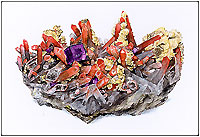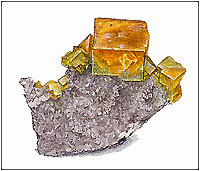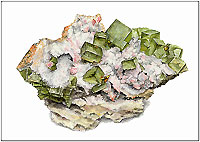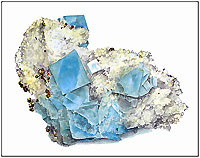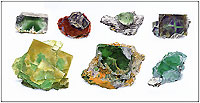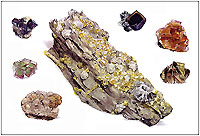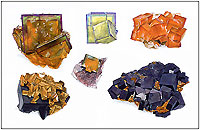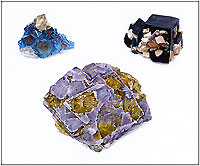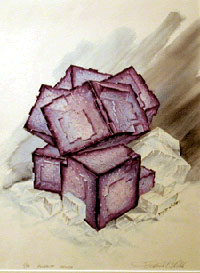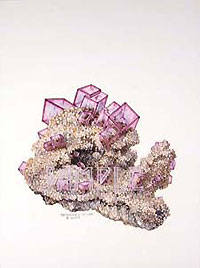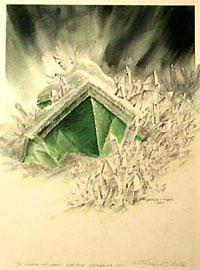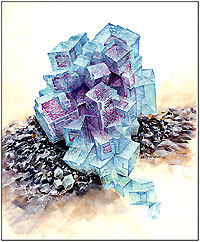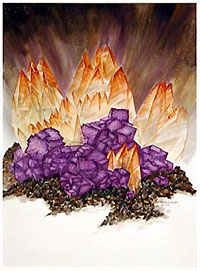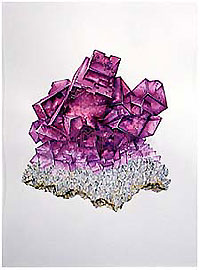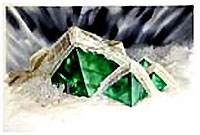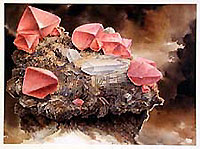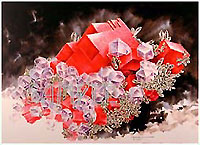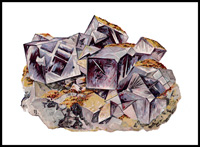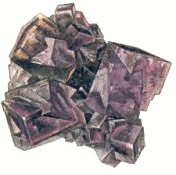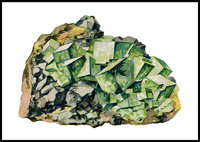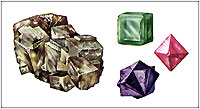|
Martin Haubenreisser
Wendell
.E.Wilson Reference:
|
||
| Source : Mineralogical Website | ||
|
|
||
| Frederick
C. Wilda Hadley, MA 01035 Fred was born and raised in the small Western Massachusetts town of Hadley. At a very early age he spent free hours drawing and painting with whatever materials he could find around his small country home. Utilizing his self taught skills and dedication, he progresses to a career as a commercial artist for over 40 years. During those years he experienced every aspect of graphic designing, from truck lettering to creating new products, packaging and promotional material for regional and international corporations. Fred devoted time whenever he could to pursuing his love of fine arts. Landscapes and wildlife were his main subjects. He found oils to be his favorite medium for most of these works. A curiosity of minerals slowly developed to infatuation over the past several years. Collecting became a favorite outdoor pastime. Acquiring lapidary equipment, he soon learned to cut cabochons and free form jewelry developing this hobby into a part time business. Mineral shows soon became a good place to acquire more specimens for a growing collection. Then his two favorite passions collided! He picked up his brush and began a series of mineral paintings. Watercolor was chosen as the medium, samples from his collection and a few borrowed from friends became his subjects. The paintings are actually a watercolor-based mixed medium. Opaque paints are applied wherever necessary to achieve the end results he is looking for. They are not meant to be photographic representations, but as he puts it, “they are meant to capture the spontaneity of that moment when you see a specimen for the first time, and to capture the essence of the beauty of minerals”. His paintings and limited edition prints are displayed at various Mineral Shows including the Connecticut Valley Mineral Club Show in Connecticut, the East Coast Show held in West Springfield, Mass, various other New England Shows, and the Inn Suites at the Tucson Arizona Show. |
||
|
|
|
|
|
|
||
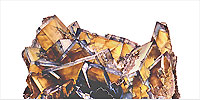 |
||
|
#MA118
|
|
Ces gravures et certains originaux sont disponibles sur le site |
|
|
||
|
|
www.wpclipart.com |
Fluorite
from Cumberland(?), England |
|
|
||
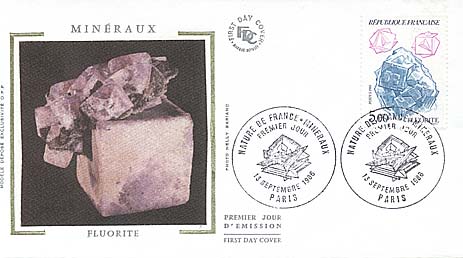 |
||
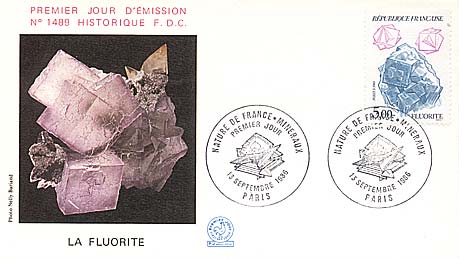 |
||
|
|
||
Raymond Perlman
(born in 1923)
Raymond Perlman earned degrees in Fine Art from the University of Illinois
at Urbana-Champaign, and also earned a Master of Professional Arts degree
from the Art Center School in Los Angeles. He then joined the art faculty
at the University of Illinois at Urbana-Champaign, eventually achieving
the rank of Full Professor of Art (in charge of graphic design) in the
1950's. His published artworks are almost entirely devoted to the illustration
of children's books, many in collaboration his friend Herbert S. Zim (1909-1994)
as author. Perlman first worked with Zim on What's Inside the Earth (1953),
What's Inside Engines (1953) and Things Around the House (1954), all children's
books. His earliest published mineralogical artworks appeared in Zim and
Paul Shaffer's Rocks and Minerals (1957), a basic mineral book for young
people which has undergone numerous reprintings over the years. Many of
the same illustrations were used in Zim and Shaffer's The Golden Stamp
Book of Rocks and Minerals (1958). Perlman also illustrated The Pacific
Northwest: A Guide to the Evergreen Playground (1959) by Zim and Natt
Dodge, The Story of Geology (1960) by Jerome Wyckoff, Zim's Rocks and
How They Were Formed (1961), Geology (A Golden Guide book) by Frank Rhodes,
and Fossils: A Guide to Prehistoric Life (1962), by Rhodes, Shaffer and
Zim (with 481 illustrations by Perlman), Secrets of the Earth (1967) by
Wyckoff, Inside the Earth (1968) by Wyler, Light and Color (1971) by Clarence
Rainwater, Steine und Steinsammlungen (1972) by Eva Evans, Ecology (1973)
by Alexander and Fichter, and Gesteine und Bodenschatze (1984) by Alice
Martin and Bertha Parker. Raymond Perlman is currently retired and living
in West End, North Carolina.
Wendell .E.Wilson
|
|
|
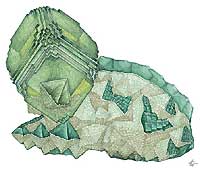 |
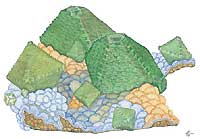 |
|
Fluorite
with quartz prisypki. The change of the growth form from octahedron
to cube with formation of phantom.
|
Fluorite.
The change of the growth form from octahedron to cube with formation
apex-edge skeletal forms.
|
|
http://mindraw.narod.ru/
|
|
Arthur Smith
(1916-1991)
British artist Arthur Smith was one of the leading scientific illustrators
of the 20th century. He was also highly prolific, producing during his
lifetime nearly 20,000 illustrations of insects as well as illustrating
56 periodical articles and several books. He was born at Eastburn in Yorkshire,
England, and as a boy became interested in natural history. At 15 years
of age he won a scholarship to the Keighly School of Arts and Crafts and
later went on to study at the Royal College of Art, London. Smith was
based at the British Museum (Natural History) from 1940 to 1973. Most
of his artwork consists of detailed scientific line drawings. He developed
a technique of using a combination of watercolor, colored inks and coloured
pencil to produce his drawings. His natural history work included vertebrates,
minerals and precious stones.
Smith produced 16 very competent and attractive color-plate illustrations
of mineral specimens for Semi-Precious Stones (1952), written by Nora
Wooster of the Brooklyn Crystallographic Laboratory at Cambridge University,
England. In the acknowledgments Smith and Wooster thank the following
people for access to mineral specimens that were illustrated: Dr. Campbell
Smith, Keeper of Minerals at the British Museum (Natural History); Dr.
J. Phemister of the Geological Survey and Museum, London; and Prof. C.
E. Tilley of the Department of Mineralogy and Petrology, Cambridge University.
Mr. C. H. Benson of the Museum of Practical Geology, and Miss J. M. Sweet
of the British Museum (Natural History) are thanked "for help given
in the drawing of the plates."
W.E.W.
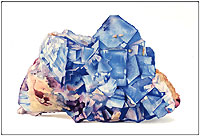 |
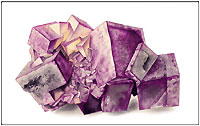 |
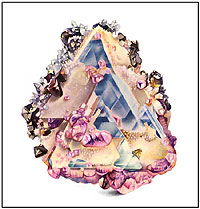 |
| Fluorite
from Derbyshire, England Watercolor/ink/pencil drawing on art paoer, 4.5 x 7 inches (1952); drawn from a specimen in the British Museum (Natural History), London. Published as Plate 15 in Nora Wooster's Semi-Precious Stones. |
Fluorite
from the Ullcoats mine, Cumberland, England Watercolor/ink/pencil drawing on art paoer, 4.5 x 7 inches (1952); drawn from a specimen in the British Museum (Natural History), London. Published as Plate 14 in Nora Wooster's Semi-Precious Stones. |
Fluorite
with Quartz and Chalcopyrite Watercolor/ink/pencil drawing on art paoer, 4.5 x 7 inches (1952); drawn from a specimen in the British Museum (Natural History), London. Published as Plate 1 in Nora Wooster's Semi-Precious Stones. |
|
|
||
Philip Rashleigh
(1729-1811)
Philip Rashleigh was born in Aldermanbury, London, in 1729, the son of
a Member of Parliament and Cornish landowner. He attended Oxford but left
without attaining a degree. He was elected a Member of Parliament himself
in 1764, and continued to serve until the dissolution of the body in 1802;
he was well respected there, and in his elder years was known as "the
father of the House of Commons." Rashleigh is famous among mineral
collectors for the superb collection of Cornish minerals he assembled,
and for the two color-plate-illustrated volumes he published in 1797 and
1802 describing his collection.
Rashleigh began studying minerals at least as early as 1758 (when he was
among the subscribers to William Borlase's Natural History of Cornwall),
and had begun actively collecting Cornish minerals by 1765. By 1794, after
three decades of collecting, his assemblage of over 4,000 mineral specimens
was described as "rich and magnificent" in books, gazetteers
and travel guides of the day. As early as 1791 he had been searching for
"a good clever man to draw and color some of my minerals," and
ultimately is said to have hired a prominent Cornish enamel painter, Henry
Bone (1755-1834), to prepare the paintings for producing 33 engravings
(to be hand-colored) illustrating 194 specimens. These were published
in 1797 as Specimens of British Minerals, Selected from the Cabinet of
Philip Rashleigh… He was not entirely satisfied with the results,
however, and complained that "there is great difficulty in representing
minerals on paper." Nevertheless, he engaged several artists to produce
a second volume in 1802, with 21 hand-colored plates depicting 48 specimens.
The artists included Rashleigh's sister Rachel (wife of mineral collector
John Gould), a well-known watercolorist and geologist named Thomas Richard
Underwood (1765-1836), and a London engraver named Thomas Medland (fl.1777-1833).
Paintings for a third, never-published volume were prepared by Harriet
Rashleigh, Miss F. Rashleigh, and James Sowerby. Philip Rashleigh died
at his family home, Menabilly, in 1811; most of his collection and the
original paintings of his minerals are preserved in the British Museum,
London, and in the County Museum, Truro.
W.E.W.
Reference: Jones, R. W. (1995) Philip Rashleigh and his Specimens of British
Minerals (1797 and 1802). Mineralogical Record, 26, 77-84.
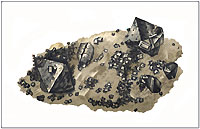 |
|
Galena
on White Fluorite from Derbyshire
Hand-colored engravings (1797) by Henry Bone, depicting a 5.1-inch specimen (from the collection of Philip Rashleigh) actual size. Mineralogical Record Library. |
![]()
